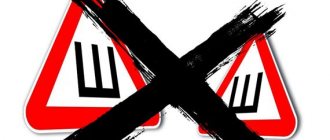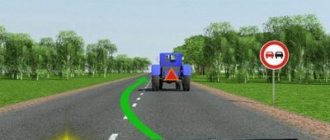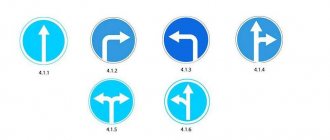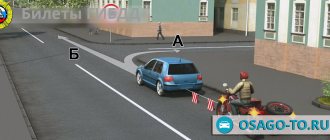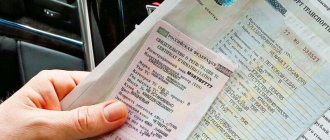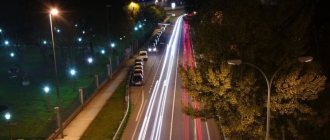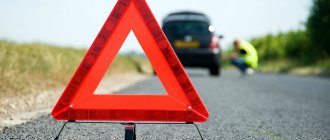Description of the sign
The “Slow Moving Vehicle” sign, a photo of which you can see in this article, complies with the conditions of UNECE regulations No. 69-01 (with amendment 01). The kit consists of one panel used as a rear identification badge. It is usually made of aluminum, but can also be presented in the form of a self-adhesive film, as well as a plate with a PVC base.
Appearance - an equilateral triangle of a red or orange hue with a yellow (sometimes red) border, the corners of which are cut off. The base of the sign is necessarily fluorescent, and the border is reflective.
Slow-moving vehicle sign: placement rules, legal regulation
Many drivers would like to call a slow-moving vehicle slow-moving and pass it around.
But not every barely moving vehicle actually falls under this definition. And confusion of concepts can lead to charges of violating traffic rules, which means punishment.
Read the article about what a low-speed vehicle is, what rules it must move by, and what maneuvers are allowed for other cars next to it.
Fines
Participation in the movement of vehicles that are technically unable to reach a speed of more than 30 km/h can lead to violation of the rules both by its driver and by other motorists. For the former, there is part 1.1 of article 12.15 of the Code of Administrative Offences. It will be applied to the driver of a slow-moving vehicle who prevented other cars from overtaking or getting ahead of their own vehicle outside the city. He will pay a fine of 1000-1500 rubles.
Another punishment that may follow for the driver of a slow-moving vehicle is imposed for the absence of a sticker on the rear of the vehicle. Section 1 of Article 12.5 of the Code applies here, according to which the motorist will be required to fine 500 rubles. Indeed, starting from 2021, the lack of a designation is included in the list of faults that prevent the use of transport.
Drivers of ordinary cars can “earn” a penalty for themselves if they incorrectly overtake a slowly moving vehicle that does not have an identification mark. This is a fine of 5,000 rubles. or deprivation of driving license for 4-6 months for driving through a continuous road or under symbol 3.20. The penalty is fair if the overtaken vehicle was simply driving slowly, did not have a sticker on it, and can travel faster than 30 km/h.
But sometimes in this situation a fine can be avoided. It is necessary to look at the passport of the vehicle being overtaken. If the maximum possible speed of up to 30 km/h is indicated there, it is low-speed. The one who overtook this car should not be punished. The driver of the overtaken vehicle must pay a fine for the lack of an identification mark.
We recommend reading about how to correctly complete overtaking through a continuous line. From the article you will learn about whether it is possible to complete overtaking through a continuous line, when it is allowed to complete overtaking, and penalties for violation. And here is more information about traffic police fines for crossing the marking line.
Drivers of regular cars should only recognize a slow-moving vehicle by the yellow and red triangle attached to it. If you focus on appearance and low speed, it’s easy to make a mistake, overtake and lose 5,000 rubles for it. or right. And in the worst case, the situation will lead to an accident, for which the person who was simply driving slowly will not be found guilty.
Designation
If there is no slow-moving vehicle sign, it is not always possible to accurately determine the maximum speed.
Slow-moving vehicles are often equipped with a corresponding sign on the rear of the body, which looks like a red triangle with a yellow, orange or red border. The inner part of the equilateral triangle is covered with fluorescent paint, and the outer part is coated with reflective paint.
If the factory marking is missing for some reason, a corresponding sticker is attached instead.
But not all drivers indicate the maximum speed of their vehicle, and sometimes road machinery may be on the road without this sign.
Where to begin
The first thing you need to do is find out what the traffic rules say about overtaking a slow-moving vehicle.
We're talking about overtaking here. And overtaking is considered to be ahead of another vehicle, which involves driving into oncoming traffic. That is, into the lane of oncoming traffic. And determining the number of stripes is not so difficult.
In order to understand when this can be done and when it cannot be done, you should take into account the signs and markings on the canvas.
There are several points where overtaking is strictly prohibited:
- bridges;
- railway crossings;
- pedestrian crossings;
- tunnels;
- sharp turns.
When driving along the lanes, you should understand that each case when overtaking a slow-moving vehicle is unique and individual.
Knowing the basics of the law helps a lot. But it does not always allow you to achieve a positive result. This is influenced by a number of factors.
Installation of designation
The “Slow-moving vehicle” sign is placed in such a way that all its characteristics must be preserved with minimal concessions - only covering no more than 10% of its surface with non-removable structural parts of the vehicle is allowed. During operation of a low-speed device, it is necessary to prevent the identification triangle from being affected by manufacturing and design defects.
The fastening, accordingly, must be strong and static - the use of rivets, screws, and special double-sided tape is allowed. It is important to provide easy access to the outer surface of the sign to periodically clean it from dirt.
Overtaking rules
If another passenger car is driving in front of the driver behind a slow-moving vehicle and does not dare to maneuver into oncoming traffic, then overtaking is prohibited.
You can overtake slow moving vehicles only in two cases, but you should consider all the rules:
- In an area where sign 3.20 “Overtaking is prohibited” is in effect, the maneuver is allowed.
- If there are continuous markings (of any type) on the road surface and there is no “Overtaking prohibited” sign, you cannot overtake.
- If there are both markings and a “No Overtaking” sign, the maneuver is allowed.
- In all other cases, any overtaking is prohibited.
In some cases, traffic regulations allow overtaking a slow-moving vehicle even in places where this maneuver is prohibited. This was done to relieve road congestion in rural and near rural areas.
If a controversial situation arises, you need to demand from the traffic police that the model of the overtaken vehicle be included in the protocol. For example, if it is known for sure that the equipment is slow-moving, but the sign was missing.
Overtaking slow-moving vehicles without any markings is a risky maneuver that can lead to undesirable consequences. If the PTS of this vehicle states that the maximum speed is more than 30 km/h, then the driver who overtook will be held administratively liable.
Good afternoon, dear reader.
It has been several years since the first resolution of the plenum of the Supreme Court was published, regulating the specifics of overtaking slow-moving vehicles.
However, many drivers still cannot understand the very concept of a slow-moving vehicle , and therefore try to overtake those who are not allowed, and where they are not allowed.
This article will examine in detail the concept of “low-speed vehicle”. Well, where slow-moving vehicles can be overtaken is discussed in a separate article:
Read more: Gas cylinders for the trunk
Accommodation and layout
When placing a sign, be sure to place it strictly with one side of the triangle facing up. In relation to the transverse vertical beam - only at an angle of 90 degrees to the longitudinal axis of the vehicle. Deviation within 5 degrees is allowed.
The designation must be presented only in the singular and located on the side of the vehicle (right or left) that is opposite to the direction of traffic in a given country.
The lower level of the symbol must be no lower than 25 mm above the ground surface, and the upper level must be no more than 150 cm above it.
Responsibility for violating traffic rules
The likelihood of non-compliance with the rules when overtaking a slow-moving vehicle is high. Here it is important not so much to fear a fine, but to take care of your life, your vehicle and respect other road users on the road. It is not by chance that I am focusing on this. The majority of accidents involve improper overtaking. Therefore, administrative responsibility calls for thinking about this again. Part 4 of Article 12.15 of the Code of Administrative Offenses provides for a fine for crossing a solid line equal to 5,000 rubles. In addition, a violation may result in the confiscation of your driver's license for a period of four to six months. If the offense is repeated, the time period of possible deprivation of rights increases to one year. In the case when a traffic violation is video recorded, only an administrative penalty is applied, i.e. fine. The measure of deprivation of rights is not applied.
Legal standards
The sign must be installed at the rear of all mechanical vehicles for which its manufacturer has determined the highest speed, not exceeding 30 km/h.
The “Slow Moving Vehicle” sign is reflected in the following legal documents:
- Technical regulations of the Customs Union 018/2011. Vehicles belonging to categories M, N, O, the highest design speed of which is not more than 40 km/h, are required to be marked with this designation.
- Federal Law of the Russian Federation No. 77. Regulation of fines for drivers of slow-moving vehicles.
- Traffic rules 11.6. The rules require that in conditions where overtaking a device equipped with a “Slow Moving Vehicle” sign is difficult or impossible, the driver of it should keep to the right or even stop if necessary to let the following high-speed vehicle pass.
- Code of Administrative Violations (Article 12.15, Part 1, Clause 1.1). Introduction of a fine for the owner of a low-speed vehicle (travelling less than 30 km/h), who did not provide the driver of a faster vehicle with the opportunity to overtake, in the amount of 1-1.5 thousand rubles.
- Code of Administrative Offenses of the Russian Federation (Article 12.15). In the spring of 2021, another penalty was introduced for drivers of slow-moving vehicles - 500 rubles for driving without an identification marking.
What does the slow-moving vehicle road sign mean?
In populated areas, the speed of traffic flow is limited. The maximum permissible speed is 60 kilometers per hour, but the average speed will be significantly less if you take into account braking at intersections, turns, and lane changes.
Dear readers! Our articles talk about typical ways to resolve legal issues, but each case is unique.
If you want to find out how to solve your particular problem, please use the online consultant form on the right or call. It's fast and free!
In such conditions, special vehicles with low speed move at the speed of the flow and are not a serious obstacle.
Outside a populated area, the situation is different - the average speed of a car increases sharply and there is a need to overtake slow-moving cars. When overtaking, it is important not to violate traffic rules and correctly assess the traffic situation.
What does the Slow Moving Vehicle sign mean and how is it designated?
The traffic rules do not define a slow-moving vehicle, but there is an identification sign.
It is installed on vehicles whose rated speed does not exceed 30 km/h. In 2021, changes were made to the traffic rules. A slow-moving vehicle must have an identification mark on the rear of the body or trailer. Violators will be fined.
A breakdown or other circumstances do not make the car a slow-moving vehicle. Any car on the road can find itself in a situation where its speed is low:
- there was a collision with an obstacle or another vehicle (the body, chassis or other component was damaged);
- the car can be loaded with oversized luggage;
- the weight of the cargo exceeds the technical capabilities of the machine;
- the driver is carrying fragile luggage;
Need to remember:
- From the point of view of the law, a slow-moving vehicle can be considered a vehicle on which an identification mark is installed.
- If there is no such sign, but you are sure that this model of tractor (excavator, grader, etc.) has a rated speed of no higher than 30 kilometers per hour and you can prove this even in court, then this is a low-speed vehicle for you.
- If you do not have full confidence in your knowledge of the technical characteristics of the car, then this is not a slow-moving vehicle.
What type of vehicle is considered low-speed?
Special equipment intended for agricultural, road or construction work usually has a . For various reasons, this sign is not on all cars in this speed category. In this case, the driver is required to mark his car with a special sticker (similar to a sign).
The most obvious low-speed vehicle is a road roller. A modern road roller reaches speeds of up to 14 km/h, but it does not move under its own power on public roads.
Tractors and many other types of special vehicles can reach speeds of 40–50 km/h or more. The D3-98 motor grader in fifth gear (according to the passport) accelerates to 41 km/h. A wheeled excavator reaches a speed of 40 km/h. Belarusian tractor - 50 km/h. K-700 - 45 km/h. They do not require an identification mark.
Is it possible to overtake a slow-moving vehicle that does not have a special sign?
On dangerous sections of the road, a sign 3.20 “overtaking is prohibited” is installed. The sign has a coverage area and prohibits overtaking any vehicle except:
- horse-drawn carts;
- bicycles (from 2.04.14);
- mopeds;
- two-wheeled motorcycles without a sidecar (trailer);
- low-speed transport;
The Plenum of the Supreme Court of the Russian Federation in 2012 clarifies the effect of sign 3.20 in the case where the sign for a slow-moving vehicle is missing, but the design speed of the overtaken vehicle is not more than 30 km/h. The resolution is difficult to apply in a real traffic situation, since it is impossible to remember all the design features of cars whose rated speed does not exceed 30 kilometers per hour.
This means that in the area covered by the “no overtaking” sign:
- the driver can confidently overtake: bicycles, carts, mopeds, two-wheeled motorcycles;
- It is risky to overtake slow-moving cars that do not have a special sign.
Rules for overtaking a slow-moving vehicle
You are driving along the road and an obstacle appears in front of your car - a slow-moving truck or slow-moving equipment. There are four possible scenarios:
Road markings and signs do not prohibit overtaking, then:
- if there are no other prohibitions from the Russian Traffic Regulations specified in paragraph 11. You can safely perform the overtaking maneuver of any car;
You cannot overtake:
- at intersections (except for the case when you are moving along a main road through an intersection without a traffic light);
- inside tunnels, on bridges and overpasses, on bridges;
- when visibility is limited by a turn or climb;
- before and at railway crossings;
- at pedestrian crossings;
- if there is interference of another kind (the vehicle in front of you turns, goes to overtake, there is no room to return to its lane);
- If there is a solid line, but there is no 3.20 sign, then it is prohibited to overtake any vehicle;
- On the road there are markings prohibiting overtaking and a sign 3.20, and on the car in front of you there is an identification sign “slow-moving vehicle”, then the road markings lose priority, you can overtake a slow-moving vehicle;
- Sign 3.20 prohibits the overtaking maneuver, and there is no special sign on the car interfering with traffic. You cannot overtake (if you are 100% sure that the speed of this vehicle in the passport is no more than 30 km/h, then overtake).
In May 2014, the Code of Administrative Offenses introduced a fine for drivers of slow-moving vehicles and vehicles that transport large or heavy loads.
A fine is imposed for violating clause 11.6 of the traffic rules, which requires drivers of slow-moving vehicles when driving outside populated areas at a speed of no more than 30 km/h:
- change lanes as far to the right as possible when overtaking or getting ahead is difficult;
- stop on the side of the road and let traffic behind him pass, if necessary;
Slow vehicles may fall under clause 11.6:
- vehicles whose speed does not exceed 30 km/h;
- heavily loaded vehicles moving no faster than 30 km/h;
- horse-drawn carts, large-sized agricultural machinery;
- any slow vehicle that takes up a lot of space in the traffic lane;
Polysemy of the concept
When passing the theoretical part of the driver's license exam, many people make the mistake of choosing the wrong low-speed vehicle in the test. Relying on intuition, future drivers include here vehicles that logically cannot reach high speeds - a bicycle, a horse-drawn cart, a tractor. However, in some tests this question is somewhat complicated: the photo for the task shows a racing bicycle, sports competitions involving horse-drawn carriages, etc. So what should you choose?
The issue is resolved very simply. Only those vehicles that have the appropriate sign can be considered slow-moving. Without it, even a tricycle and an antediluvian cart cannot be called a slow-moving vehicle.
Interpretation of the concept
There is no clear definition of the concept in road regulations. However, you can determine what a low-speed vehicle is according to traffic regulations if you refer to the decoding of road signs. In particular, if we consider the symbol in the form of a red triangle with identical sides and a yellow edging along the edges, then it actually designates slowly moving objects on the road.
It turns out that a low-speed vehicle is any vehicle that, due to its technical characteristics, cannot accelerate to a speed exceeding 30 km/h.
Automatically classifying any slowly moving object as slow-moving is a wrong decision.
In this case, punishment may follow for ignoring traffic rules. Only that road user whose body has a slow-moving vehicle sign can be considered such. If within the city limits, due to the presence of intersections, traffic lights and eternal traffic jams, all cars travel at approximately the same average speed, then on the highways the question inevitably arises of what rules should be used to bypass a car traveling at a snail’s speed. Few drivers can know for sure the rated power of another car.
There can be many reasons for slow driving:
- the vehicle is currently transporting fragile cargo;
- the machine is overloaded;
- the car is faulty.
However, driving at low speeds is not considered a legal reason for classifying a vehicle as a slow-moving vehicle. The only argument is the slow-moving vehicle sign.
Traffic regulations and slow-moving vehicles
Point No. 11 of the Russian traffic rules strictly prohibits overtaking slow-moving vehicles on the following sections of the route:
- Regulated (with traffic lights) intersections.
- Unregulated intersections when driving on a non-main road.
- Railway crossings, as well as areas at a distance of no more than 100 m from them.
- The vehicle in front of you is detouring or overtaking an obstacle.
- Bridges, overpasses, tunnels, overpasses and sections of the highway under them.
- The vehicle following you began to overtake.
- Dangerous turns, ends of climbs, areas with limited visibility.
- Once you have overtaken, you will not be able to get back into the lane without creating a hazard or obstructing the road.
Sign 3.20 “Detour, overtaking prohibited” does not allow you to overtake all vehicles, except for low-speed ones - bicycles, mopeds, horse-drawn vehicles, two-wheeled motorcycles, which not only move less than 30 km/h, but also have an identifying bordered triangle. With a solid line (designation 1.1, 1.11), even a low-speed vehicle cannot be overtaken.
That’s all we wanted to tell you about the GOST requirements for the “Slow-moving vehicle” sign, as well as the rules for driving slow-moving vehicles, overtaking them according to the Russian Federation Traffic Regulations, as well as other legislative acts.
Slow-moving vehicle sign
> Miscellaneous
16.03.2020
The increasing number of motorists from year to year forces legislative bodies to adjust and introduce new provisions into the laws regulating the movement of vehicles.
The term low-speed vehicle has recently been coined.
However, many drivers find it difficult to know which vehicles are classified as such, and what are the features and rules for their movement on the roads.
Interpretation of the concept
There is no clear definition of the concept in road regulations. However, you can determine what a low-speed vehicle is according to traffic regulations if you refer to the decoding of road signs. In particular, if we consider the symbol in the form of a red triangle with identical sides and a yellow edging along the edges, then it actually designates slowly moving objects on the road.
It turns out that a low-speed vehicle is any vehicle that, due to its technical characteristics, cannot accelerate to a speed exceeding 30 km/h.
Automatically classifying any slowly moving object as slow-moving is a wrong decision. In this case, punishment may follow for ignoring traffic rules. Only that road user whose body has a slow-moving vehicle sign can be considered such.
If within the city limits, due to the presence of intersections, traffic lights and eternal traffic jams, all cars travel at approximately the same average speed, then on the highways the question inevitably arises of what rules should be used to bypass a car traveling at a snail’s speed. Few drivers can know for sure the rated power of another car.
There can be many reasons for slow driving:
- the vehicle is currently transporting fragile cargo;
- the machine is overloaded;
- the car is faulty.
However, driving at low speeds is not considered a legal reason for classifying a vehicle as a slow-moving vehicle. The only argument is the slow-moving vehicle sign.
Description and requirements for the sign
Visually, a slow-moving car in the traffic police rules is illustrated in the form of an equilateral red triangle. The figure has a yellow border, as well as cuts along the edges. Due to the fundamental importance of having an appropriate image, the dimensions of the slow-moving vehicle sign are regulated by the guest.
In order for it to be clearly visible to cars passing by, the following requirements are imposed on the image parameters:
- overall dimensions should be from 350 to 365 mm;
- the width of the edging should be in the range of 45-48 mm;
- the central red base must have a fluorescent coating;
- The edging of the sign must be reflective.
It is allowed to make a sign from the following materials:
- self-adhesive film;
- aluminum;
- canvas with PVC base.
There are also a number of requirements for installing the sign:
- the mounting location must be located on the rear of the vehicle body;
- one of the corners of the triangle should be located strictly upward (a discrepancy of only 5 degrees is acceptable);
- the height of the upper part of the sign cannot exceed 150 cm above the ground;
- the lower part of the triangle cannot hang closer than 25 cm from the ground;
- the marking must be clearly visible to others; 10% overlap is allowed, but only if this is due to the design features of the road user;
- The presence of damage and defects on the sign is unacceptable.
The sign can be attached using screws, rivets and double-sided tape. The image of the red three-sided figure on the vehicle appears in only one place - the left side of the rear body of the car. Additional duplication of the symbol in other places on the body is unacceptable.
If there is no red-yellow triangle symbol on the slow-moving vehicle, traffic police officers have the right to fine the violator.
Rules for avoiding slow traffic participants
According to established regulations, all aspects of vehicle movement are strictly regulated. The legality of performing an overtaking maneuver is also described in the law.
In emergency areas, vehicle drivers are limited in their freedom of movement like nowhere else. In most cases, a “No Overtaking” warning is installed in such zones.
However, what to do in a situation where an object, equipped with a low-speed vehicle marking, is moving along a highway at a speed of 15 km/h.
If there is a sign prohibiting overtaking of the car in front, the driver is allowed to bypass:
- mopeds;
- harnessed carts;
- bicycle transport;
- motorcycles not equipped with a cradle;
- low-speed vehicle.
Such a permit is valid only if there is a “No Overtaking” road sign. If the road has a continuous dividing strip, then in the absence of a sign, crossing it is impossible even to overtake a slow-moving vehicle. In a situation where both a sign and continuous markings are installed, it is possible to overtake the above types of transport, but only within the coverage area of the sign prohibiting detour.
According to the provisions of the Code of Administrative Offences, if a slow-moving vehicle interferes with the normal movement of other cars on the road, then the driver is obliged to take all measures to resolve such a situation. This can be either an adjustment of one’s own trajectory of movement to the right, or a complete stop.
It should be noted that in areas containing structures such as bridges, overpasses or tunnels, passing by any vehicle, regardless of its speed, is strictly prohibited. You cannot perform overtaking maneuvers either on or under such buildings.
It should be noted that in areas containing structures such as bridges, overpasses or tunnels, passing by any vehicle, regardless of its speed, is strictly prohibited. You cannot perform overtaking maneuvers either on or under such buildings.
The traffic rules define a list of places where overtaking slow-moving vehicles is prohibited:
- intersections equipped with traffic lights or other means of traffic control;
- railway crossings and overpasses, including sections of the road leading to them (their length is 100 meters before and after crossing the railway tracks);
- uncontrolled intersections if vehicles travel on a secondary road;
- if the maneuver creates an emergency situation on the route;
- the car in front goes around an obstacle or overtakes;
- if there is another car moving between the driver and the slow-moving vehicle that is not overtaking;
- the following car began to overtake;
- the presence of a continuous marking line and the absence of a sign prohibiting overtaking;
- in areas with poor visibility;
- presence of signs indicating dangerous turns;
- at pedestrian crossings;
- at the ends of steep slopes.

